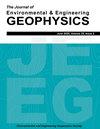Evaluation of Electrical Resistivity for Non-destructive Seepage Detection on an Urban Underground Diaphragm Wall
IF 0.7
4区 工程技术
Q4 ENGINEERING, GEOLOGICAL
引用次数: 3
Abstract
With the continuous development of urban underground space, non-destructive methods for diaphragm wall leakage detection are becoming increasingly important. Recent studies have shown that the apparent resistivity, stimulated current, and self-potential can be used as indicator parameters for non-destructive diaphragm wall leak detection. The diaphragm wall seepage evaluation of a subway station was carried out using the above indicator parameters. The response characteristics of apparent resistivity, stimulated current, and self-potential were obtained before and after excavating the diaphragm wall. The results obtained by this study reveal that an area is very likely to be a seepage area when there are significant differences amongst the three measurement parameters. The self-potential is greatly affected by field interference; the stimulated current is a direct sign of seepage, and indicates that seepage occurs when the stimulated current increases; the apparent resistivity macroscopically indicates rupture or seepage in the diaphragm wall. The field experiment verified the feasibility of detecting diaphragm wall seepage using coupled analysis based on electrical resistivity and self-potential methods.城市地下连续墙无损渗流检测的电阻率评价
随着城市地下空间的不断发展,地下连续墙的无损检测方法显得越来越重要。近年来的研究表明,视电阻率、受激电流和自电位可以作为地下连续墙无损检漏的指示参数。利用上述指标参数对某地铁站地下连续墙进行了渗流评价。获得了地下连续墙开挖前后视电阻率、受激电流和自电位的响应特征。研究结果表明,当三个测量参数之间存在显著差异时,该区域很有可能是渗流区。电场干扰对自电位的影响较大;受激电流是渗流的直接标志,表明受激电流增大时发生渗流;视电阻率在宏观上指示地下连续墙破裂或渗漏。现场试验验证了电阻率法与自电位法耦合分析地下连续墙渗流检测的可行性。
本文章由计算机程序翻译,如有差异,请以英文原文为准。
求助全文
约1分钟内获得全文
求助全文
来源期刊

Journal of Environmental and Engineering Geophysics
地学-地球化学与地球物理
CiteScore
2.70
自引率
0.00%
发文量
13
审稿时长
6 months
期刊介绍:
The JEEG (ISSN 1083-1363) is the peer-reviewed journal of the Environmental and Engineering Geophysical Society (EEGS). JEEG welcomes manuscripts on new developments in near-surface geophysics applied to environmental, engineering, and mining issues, as well as novel near-surface geophysics case histories and descriptions of new hardware aimed at the near-surface geophysics community.
 求助内容:
求助内容: 应助结果提醒方式:
应助结果提醒方式:


